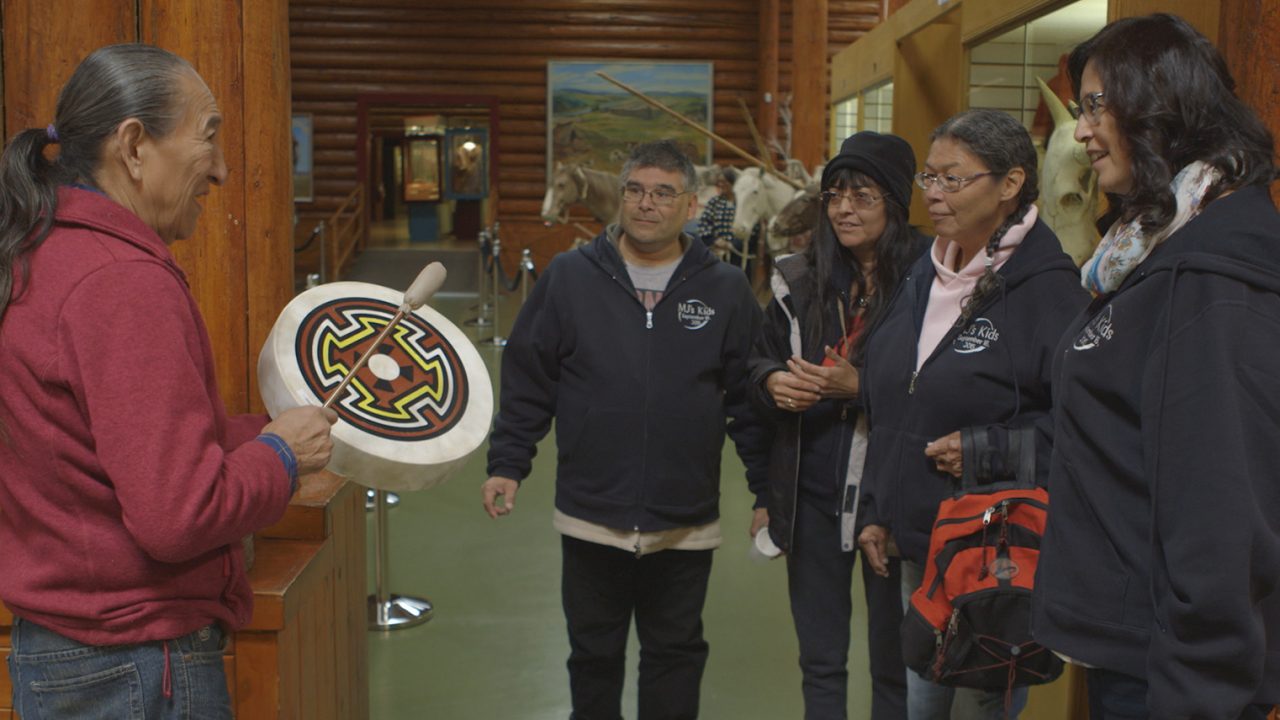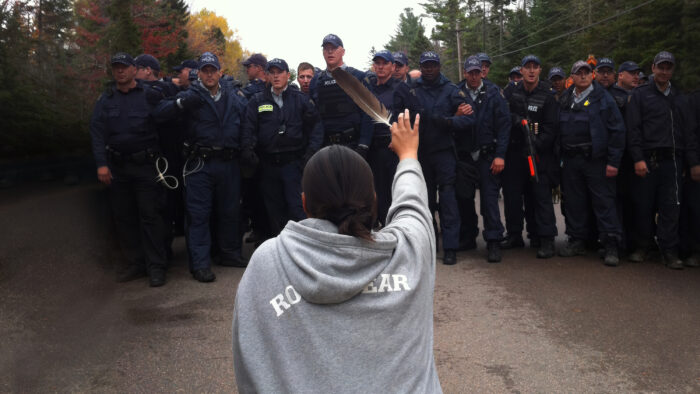
Mini-Lesson for Birth of a Family
Mini-Lesson for Birth of a Family
Mini-Lesson for Birth of a Family
School Subjects:
- Indigenous Studies: History and Politics, Issues
- Family Studies/Home Economics: Family Diversity and Challenges
Ages: 12-14
Warning: Some swearing (e.g., “f****** s***,” “dickhead”)
Birth of a Family, Tasha Hubbard, provided by the National Film Board of Canada
Keywords/Topics: Identity, Family, Sixties Scoop, Forced Assimilation Policies, Institutional Racism, Adoption, Child Welfare, Foster Care
Overarching Question: What are the immediate and long-term social implications of the Sixties Scoop, and what actions towards healing can we take as individuals, families, communities, and as a society?
Educational Synopsis: Birth of a Family invites viewers to bear witness to an intimate, once-in-a-lifetime, emotional encounter. This documentary captures the first meeting of Mary Jane Adam’s children, Betty Ann, Rosalie, Esther and Ben, who were taken from their mother when they were babies as part of the “Sixties Scoop.” The term refers to the practice of removing Indigenous children from their families and displacing them into non-Indigenous foster or adoptive families, which began in the 1960s and continued until the late 1980s. The taking of children from Indigenous families began with the Residential School system and transitioned into the child welfare system, which overlapped with the Sixties Scoop. The impacts of this practice, which led to the breakdown of Indigenous families, continue to resonate today. The film’s director, Tasha Hubbard, was also adopted during the Sixties Scoop in Canada.
Activity 1: Reflect and Sketch
Clip #1 (7 min 29 s)
Have students reflect silently on what makes a healthy family. What is needed to support the growing, well-being and nurturing of children within a family?
Step 1: Have students use a pencil to sketch a simple tree with leaves or pine needles and roots. Have them place their names in the trunk of the tree.
Step 2: Have students draw 4 or 5 raindrops big enough to hold one or two words.
Step 3: Place 5–10 words that describe the characteristics of a healthy family within the raindrops and roots of the tree.
Summary
The tree is a symbol of how a child will grow and thrive when supports (raindrops of nourishment) are in place to nurture their growth.
Indigenous families and communities were broken down by systems of oppression that viewed families as lacking the ability to nurture the child, when in fact traditional child-rearing practices surround and nurture the child and place them at the centre of family life. Nurturing supports are grounded in love from parents, aunties, uncles, grandparents and the community. Everyday experiences such as songs and ceremonies shaped the overall well-being of the child, as well as their growth and sense of belonging.
The roots of a healthy family began to break down, in part, when children were forcibly removed and put in isolated and harsh environments (Residential Schools) that neglected, abused, belittled and demeaned the child’s sense of belonging and self-love.
The mother in this documentary was taken from her family and placed in a Residential School, and in turn her children were “scooped”—divided and placed into foreign environments, thus continuing the cycle of fractured families. The siblings in the video are now nurturing their sense of family belonging by taking steps to heal and support one another so that they can flourish together.
For more information about a tree model depicting the nurturing of a healthy child, refer to the First Nations Holistic Lifelong Learning Model.
Activity 2: Reflect and Branch Out
Clip #2 (7 min 15 s)
When the siblings meet an Elder at Buffalo Nations Luxton Museum, they learn about and experience some elements of Stoney Nakoda culture for the very first time. The elder says “Welcome home.” Betty Ann reflects on her experience and describes the feeling of having been “ripped off.”
Step 1: Have students discuss with a partner or small group the emotional impact of the meeting on the siblings, what the words “welcome home” mean to them, and why it would trigger Betty Ann to express her feelings of having been ripped off.
Step 2: Have students consider how connection to culture can nourish a sense of well-being.
Step 3: Students add new words or characteristics around the tree from Activity 1 based on how connection to culture can nourish a sense of well-being.
Step 4: Have them colour the tree, rain drops, words and background using pencil crayons.
Step 5: After they are done colouring, reveal to them that the colours represent the importance of the connection to culture, belonging and overall well-being.
Summary
Their meeting with the Elder is an important, pivotal moment in the siblings’ healing journey, as their understanding of their disconnect from their ancestral culture is heightened through this experience. This portion of the film emphasizes the fact that they share the impact of not having a grounding in their Dene culture, language, family and community.
Although this brief clip doesn’t capture the full depth of the Stoney Nakoda Nation’s connection to their cultural practices, it is an entry point for deeper learning and understanding connection to the heart of the family. The drum is reflective of the heartbeat of our mothers. It is the first rhythm we hear and feel. The emotional impact of hearing the drum, and what it symbolizes, brought up deep emotions—bringing the siblings even closer together and activating the healing process.
When the Elder says, “Welcome home,” the siblings begin to symbolically enter the circle of love and nurturing that comes with connecting to their inherent cultural ways and each other, thus contributing to their healing journey.
Activity 3: Reflect and Mind Map
Clip #3 (1 min 51 s)
As a class, reflect on how generations of forcible disconnect and negative attitudes and beliefs about Indigenous families can impact the overall well-being of individuals, families and communities. Students will also generate a list of actions that can be taken to motivate healing and flourishing.
Step 1: Write the word “Healing” at the centre of a white board or a large piece of paper. Draw four sections surrounding the word. Place one of the following words in each quadrant: Individual, Family, Community, Society.
Step 2: Have students write words or phrases on sticky notes that reflect negative social implications and attitudes that Indigenous families may face as a result of policies and attitudes that contribute to the fracturing of families. Place the sticky notes anywhere on the white board or paper.
Step 3: Have students generate ideas on how individuals, families, community and society as a whole can acknowledge, learn and take actions towards healing. Have them write ideas on sticky notes of different colours or use a different colour pen or pencil for each idea.
Step 4: Place their ideas onto the whiteboard or paper.
It is important to emphasize that some sticky notes could appear in all quadrants, because child, family, community and society are interconnected.
Summary
Colonization tactics ueled by aggressive forced assimilation policies, such as the Indian Act, the Reserve System, Residential Schools, child welfare, the Sixties Scoop and now the foster care system, continue to impact families, although healing is taking place.
Policies and negative attitudes aimed at Indigenous people have attempted to fracture and wipe out culture rooted in connection to family, ceremonies, language and the land. There have been short- and long-term social implications, such as high suicide rates, incarceration, foster care, substance abuse, language degradation, land displacement, homelessness, systemic and overt racism, as well as the perpetuation of hate towards First Nations, Métis and Inuit.
Celebrating and regaining cultural ways of being, knowing and doing can contribute to healthy families, community and society. Healing opportunities include reconnecting families and confronting the truths of Canadian history, which is rooted in the erasure of Indigenous people. Supporting the dismantling of overt and systemic racism, by learning about policies and attitudes that continue to impact families and by supporting social programs, is one way to take action towards healing.
Embedding the relearning of the Canadian and pre-contact “Indigenous” past and present into the education system as well as other systems of power (justice, social, child welfare, healthcare, public servants, media), and following through with the Truth and Reconciliation Calls to Action, will move Canada forward on the path towards healing.
Mini-Lesson Summary
The impacts of the Sixties Scoop on children who were taken from their families are very similar to the impacts felt by Survivors of Residential Schools, and it can be argued that the Sixties Scoop came about as a result of the Residential Schools. As a consequence of this separation from family and community, children did not learn about their culture, which includes language and connection to the land. They were deprived of family and community relationships, interactions and nurturing.
The legacy of the Sixties Scoop continues to affect the children who were part of that era.
Take Action
In small groups of 2–3 students, explore the Sixties Scoop by reading this journal article below. Have each group focus on one aspect of the Sixties Scoop (e.g., government policies, separation of families, impact on mothers, long-term impact on Indigenous families and communities, loss of language and culture, a film review of Birth of a Family, etc.). Students will write an article on an aspect of the Sixties Scoop and create an informational newsletter or website that includes all topics covered.
Pour lire cet article en français, cliquez ici.
Crystal is a Cree/Dene Métis mother, Educator, Indigenous Education Consultant, and artist who is dedicated to supporting the Calls to Action. She has a background in New Media studies at the Vancouver Film School, a Bachelor of Education, a fine arts degree and a master’s degree in Educational Technology, as well as an Indigenous Creative Writing and Visual Arts diploma from the En’okin Center. She also has extensive experience teaching in First Nations communities, and experience in resource development, research and the facilitation of Indigenous Education for teachers across the province of Alberta, as well as in teaching educational technology to pre-service teachers.
Discover more Mini-Lessons | Watch educational films on NFB Education | Watch educational playlists on NFB Education | Follow NFB Education on Facebook | Follow NFB Education on Pinterest | Subscribe to the NFB Education Newsletter




Thank you for these additional resources. At the end of the “Mini Lesson” page, a journal article is mentioned, but I don’t see a link for the article, or a title to go search for it on my own. Could you please clarify which article you’re referencing? Thanks!
“In small groups of 2–3 students, explore the Sixties Scoop by reading this journal article below.”